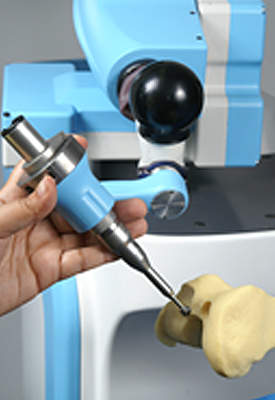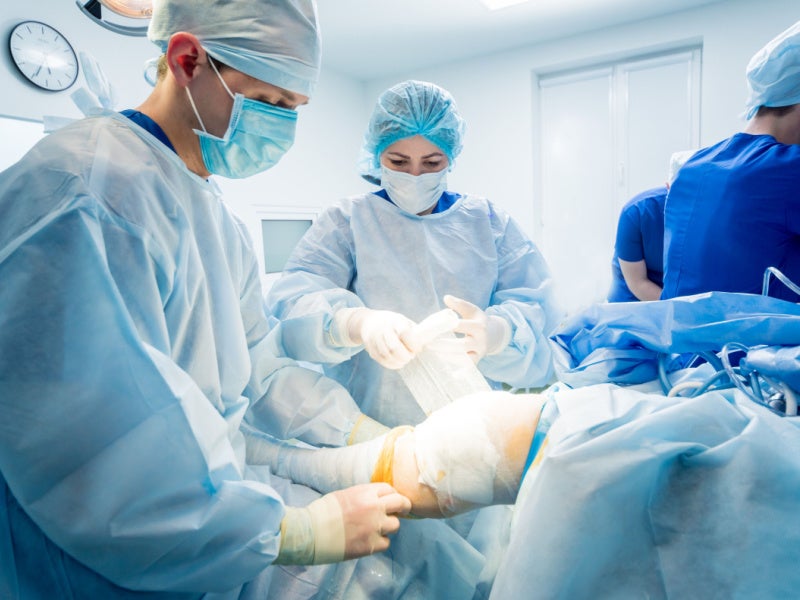
Seated at a console beside his patient lying anaesthetised in the operating theatre, the surgeon grasps his tools like joy sticks in a simulated computer game.
Operating in real time watching the surgical field on a screen in front of him he starts the intricate procedure making tiny incisions but not once does he touch his patient. His hands have been substituted for four electromechanically enhanced robotic arms, his fingers guided by force feedback as a substitute for tactile sensation.
Welcome to the future of surgery where robotics rule.
Robotics used in surgery are offering patients shorter hospital stays, less risk of infection, less scarring and a faster return to their normal daily lives. The technology being used today is just the beginning. As the technology becomes more mature, countries like the UK, where take up was previously slow, are fast becoming world leaders in their field.
But the cost and regulatory measures associated with the technology are still holding it back from Britain’s operating theatres. Professor Peter Brett of the Institute of Mechanical Engineers says innovative surgical companies like Acrobot and Prosurgics, both of which produce robotic surgical systems, are leading the way developing medical robotics in Britain.
See Also:
However, more money needs to be invested in research and regulatory controls need to be reviewed before development is really encouraged.
How well do you really know your competitors?
Access the most comprehensive Company Profiles on the market, powered by GlobalData. Save hours of research. Gain competitive edge.

Thank you!
Your download email will arrive shortly
Not ready to buy yet? Download a free sample
We are confident about the unique quality of our Company Profiles. However, we want you to make the most beneficial decision for your business, so we offer a free sample that you can download by submitting the below form
By GlobalDataROBOTICS POPULARITY AND POTENTIAL
The use and potential of robotics was recently highlighted at an Institute of Mechanical Engineers (IMechE) conference in March where the da Vinci robot was used to show how robotics is saving lives. Consultant surgeon Mr Prokar Dasgupta, performed a prostatectomy using the da Vinci, live, via video link in the hope that such a display would promote much needed investment and further research.
With the robotic arms rotating 360° the da Vinci allows surgeons far more precision than they would have using their own hands but even then, the technology is still not reaching its full potential, according to Brett.
“In terms of the potential for robotic surgery we are right at the beginning,” he says. “These tools already allow for a level of accuracy and consistency way beyond that possible by traditional methods. The latest technology provides the surgeon with superior visuals and enhanced dexterity.
“The challenge is to maintain an acceptable level of perception for the surgeon as the technology becomes smaller. The possibilities are vast.”
The first ever prostatectomy performed by the da Vinci robot was carried out five years ago by Professor Lord Darzi, one of the leading forces behind developing robotic surgery at Imperial College London.
The college is headed by Lord Darzi and Professor Guang-Zhong Yang. Yang believes the future of robotics lies in smaller devices which perform complicated aspects of surgery where a surgeon’s hand may not be as accurate.
“The issues are that the current system is too expensive and cumbersome to use and they may affect normal surgical flow,” he says. “Current devices are bulky – these are the issues that need to be addressed.”
NEW DEVELOPMENTS
The Imperial College received a £10m boost from the Helen Hamlyn Trust in March to develop robot-assisted medical techniques with a view to making Britain a world leader in robotic device development. Developments at the college include i-snake – a snake-like device which wiggles through areas difficult to access which, it is hoped, will simplify procedures in cardiovascular surgery.
Yang also says his team is also working on devices to improve surgical vision and a device which recognises tissue definition. He says the challenge is to develop robotics for surgery which have intelligence but are still under the control of the surgeon.
Other developments include Acrobot’s surgical robot for use in hip replacements. A surgeon-controlled device, the Acrobot enables better bone preparation and more accurate implant positioning. Showcased in America at the American Association for Orthopaedic Surgeons’ annual meeting in March, trials of the technology are currently underway at Warwick, Bath and Truro Hospitals in the UK and at London Clinic.
Prosurgics is another company that is at the cutting edge of robotics in the UK according to Brett. It has developed the image-guided PathFinder which enables surgeons to achieve higher accuracy in neurosurgery. Another of its products – the EndoAssist – works as a robotic manipulator for the endoscope and is already used in thoracic and abdominal surgery.
Leaders in the field say the future of the industry, however, rests with in-vivo devices which function entirely within the patient’s body; and Natural Orifice Transluminal Endoscopic Surgery (NOTES), which using a patient’s natural orifices to get to surgical sites, taking away the need for abdominal incisions altogether.
One innovation being worked on in the US by Nebraska Surgical Solutions involves inserting miniature robotic devices inside an inflated body cavity where the in-vivo robots work as cameras, controlled remotely, simplifying tool placement and ultimately enabling surgeons to perform more procedures by helping surgeons overcome problems with maneuvering and visibility in laparoscopic procedures.
In the case of NOTES the surgeon inserts surgical tools through a natural orifice to perform surgery without any external incisions.
In one example, endoscopic tools are inserted into the patient’s mouth, down the oesophagus and into the stomach. An incision is then made on the interior surface of the stomach to gain access to the abdominal
REGULATORY BARRIERS
Britain may be proving it is an innovator, but, according to Brett, there needs to be more discussion surrounding the UK’s regulation of new robotic devices. He says while patient safety is paramount, “for some things I think you have to ask the question: are we going too far on some of this?”
Brett’s most recent experience was in the development of a new device dubbed the micro-drill, designed for use in delicate inner-ear surgery. It was approved by the ethics committee for three trials but has since been shelved because of regulatory controls.
“[This was] as a result of the standards and the way things are although we could have 30 or even 300 trials, we weren’t allowed to,” he explains.
In the UK, the medical device directives of the EU are interpreted in such a way that once two or three patients have successfully undergone the robotic procedure, if further data is required for statistical evidence to support to device, either the equipment must have a CE mark, or a MHRA-approved trial must be undertaken. This makes clinical implementation extremely difficult, expensive and has an adverse effect on research, according to Brett.
Instead, Brett says the UK should take a similar stance to that of France and Germany where there is no objection to research bodies undertaking as many of the procedures as they wish, with the view that if it is safe to use on a few patients it should be safe to use on more.
WHAT IS BEING DONE
Dr Christopher Brittain from the UK Medicines and Healthcare Products Regulatory Authority says robotic technology is advancing so rapidly that regulatory measures are having trouble keeping up. As a result, the MHRA has recently established a medical device forum to ensure new technology is appropriately monitored and is calling for submissions on potential discussion topics for the forum, expected to take place in November 2008.
He believes the use of robotics in surgery should be on the table and says the forum was established after contact with industry bodies which felt they were not engaged enough with the UK regulator.
“The main reason [we are having this forum] is to look at the future technology and make sure it can be managed and it is going to be safe and also to make sure that we’re appropriately engaged with industry and aren’t causing unnecessary regulatory barriers,” he says.
Discussion on the use of robotics in the UK medical industry cannot come too soon. Statistics from the United Nations Economic Commission for Europe state there is robotic research and development in progress at over 100 universities. And in 2005 the market for surgical robotics globally was already worth $250m.
“I think it’s inevitable that within the next ten years, we won’t be putting the surgeon’s hand in a patient’s body any more,” says Brett. “We’ll do surgery using small instruments that are clever and can move in a precise way.”
The move towards intelligent tools that are safe promises a bright future.




